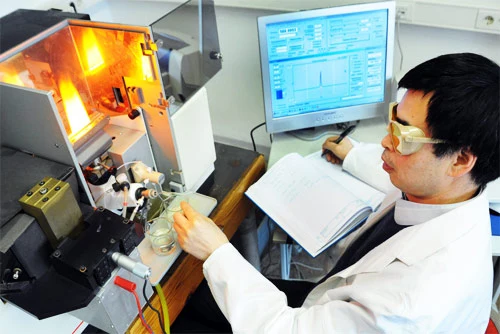Searching for traces in a new light
ISAS and Analytik Jena enrich chemical research with analysis devices
When the top US firm Perkin Elmer withdrew in 2001 from its location in Überlingen by Lake Constance, the industrial experts for instrumental analytics in South Germany and the spectroscopy specialists at today’s Berlin Leibniz Institute for Analytical Sciences (ISAS) were faced with the pending doom of their successful cooperation. This cooperation had powered some interesting joint developments, for instance a new variant of atomic absorption spectroscopy (AAS).
AAS is an established method for the highly precise determination of e.g. minimal traces of toxic substances in drinking water or high concentrations of agents in chemical production processes. AAS involves atomising the substances for analysis by heating them in a flame or graphite tube and then irradiating them with light. Different atoms absorb different wavelengths which then appear as dark lines on the light’s spectrum as registered in a spectrometer.
For a long time, a separate light source of the corresponding wavelength had to be used for each atom searched for. This has now been superseded by a method developed by a team of researchers headed by Stefan Florek and Helmut Becker-Ross at the ISAS. This method utilises a system made up of an extremely brilliant xenon arc lamp and a high resolution spectrometer with a fast linear array transducer that can cover the entire range of wavelengths.
“That was the real turning point for AAS. Thanks to the work that had already progressed to this unusual extent, we decided to tackle the commercialisation of the method by developing an even more compact and even faster device,” explained Gerhard Schlemmer, Head of Development at Analytik Jena.
And so, in 2002, Überlingen became a research and development location for this Jena company specialising in analytical measuring technology. Just two years later, the new ContrAA was launched on the market. It quickly became clear that this AAS device had even more potential: it could detect a number of atoms that had escaped detection to date, also molecules, and could analyse extremely small samples in the nanolitre range. This proves not only to be a commercial success for environmental and process analytics, consumer protection, and medicine.
“Because our device can measure with essentially greater precision and accuracy, we also afford an important contribution to basic research in analytical chemistry,” stressed Stefan Florek, who values greatly the cooperation with his colleagues in industry. Also Analytik Jena profits – in additional areas – from this close cooperation: “This is a great boost to our reputation because we are demonstrating our position at the forefront of technology.
The next joint project is the next revolutionary step: at last the even faster, because simultaneous measurement of a large number of elements.
by Uta Deffke
